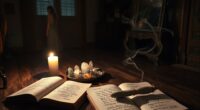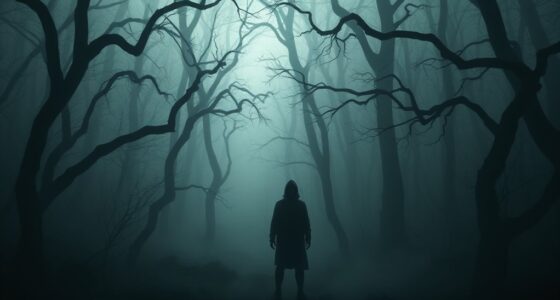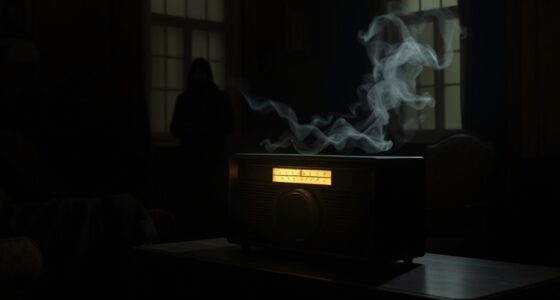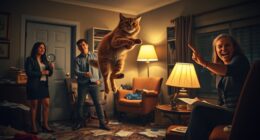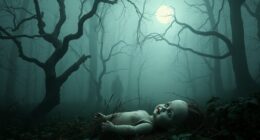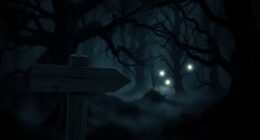Testing ghost theories with science involves applying critical thinking and empirical methods to understand claims. While many people report ghost sightings, psychological factors like stress and sleep deprivation often explain these experiences. Environmental elements, such as temperature changes and sounds in large spaces, can create illusions of the supernatural. Researchers now employ advanced tools to study these phenomena systematically. If you’re curious about the latest methods and findings in this intriguing field, there’s more to explore.
Key Takeaways
- Scientific skepticism demands empirical evidence for ghost phenomena, often lacking in anecdotal claims.
- Controlled environments simulate haunted conditions to test psychological and environmental influences on ghost experiences.
- Advanced technology, like infrared thermometers and digital voice recorders, aids in measuring environmental anomalies associated with ghost sightings.
- Psychological assessments help explain hallucinations and misinterpretations, enhancing the understanding of ghost-related experiences.
- Collaboration with neuroscience and environmental science experts promotes a rigorous approach to investigating ghost theories.
Understanding Ghost Beliefs and Encounters
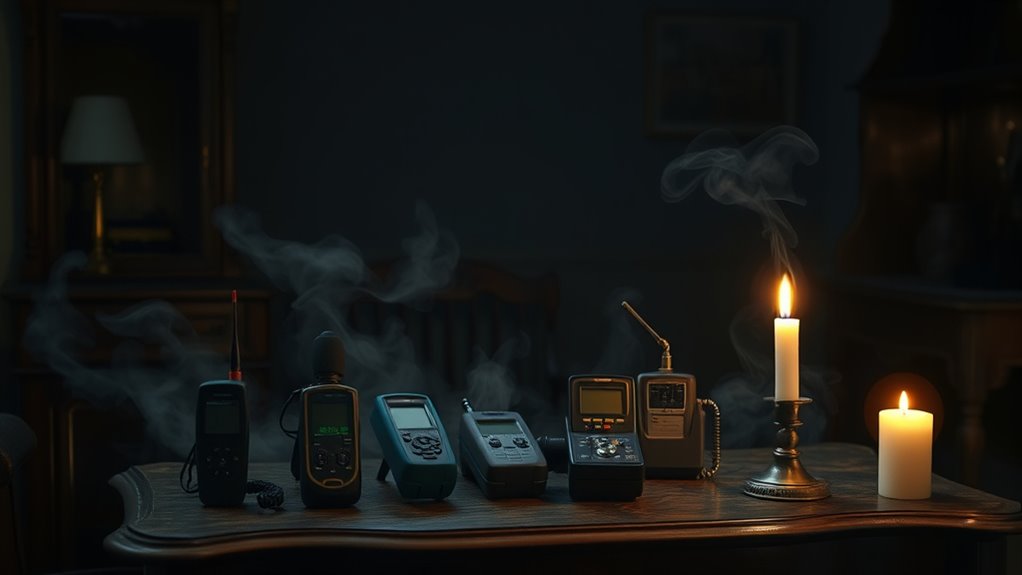
Have you ever wondered why so many people believe in ghosts? About 41% of American adults do, with 20% claiming personal ghost sightings. This belief isn’t just a passing trend; a 2018 survey found that 58% believe certain places can be haunted. Many report strange noises or shadowy figures, fueling these paranormal beliefs.
In addition, an estimated 50 million spirit encounters occur in the U.S., showcasing how deeply ingrained this concept is in society. Ghost-hunting shows often use scientific instruments to measure spirit activity, yet the evidence remains inconclusive.
Some experiences, like sleep paralysis, might explain feelings of being haunted, but the allure of the unknown keeps people fascinated by the idea of ghosts and their potential presence in our lives.
The Scientific Skepticism of Paranormal Claims

While many people are captivated by ghost stories and personal encounters, the scientific community approaches these claims with skepticism.
Here are some reasons why:
- Extraordinary claims like the existence of ghosts require extraordinary evidence, which is often lacking.
- Anecdotal evidence from personal stories is subjective and doesn’t hold up under scientific scrutiny.
- Many experiences attributed to ghosts can be explained by psychological phenomena, such as misinterpretations of sensory data.
- Critical thinking is essential; many ghost encounters can be debunked through rational investigation.
Ultimately, without empirical evidence or biological functions linked to ghosts, the validity of these paranormal beliefs remains questionable.
Embracing a scientific viewpoint allows for a clearer understanding of these claims.
Hallucinations: The Psychological Aspect of Ghost Sightings

When exploring ghost sightings, it’s crucial to contemplate the role of hallucinations, as they can often explain otherwise inexplicable experiences.
Psychological factors play a significant role in how you interpret strange occurrences. If you already believe in ghosts, you’re more likely to see them in ambiguous situations. Hallucinations can manifest due to stress, sleep deprivation, or even high temperatures, making you more susceptible to interpreting ordinary phenomena as supernatural.
Curiously, studies show that those who report more hallucination-like experiences often excel at identifying faces, hinting at a connection between perception and belief.
Additionally, inattentional blindness can cause you to miss environmental factors that might clarify what you think you saw, further fueling the ghost narrative.
The Role of Environmental Factors in Ghost Experiences
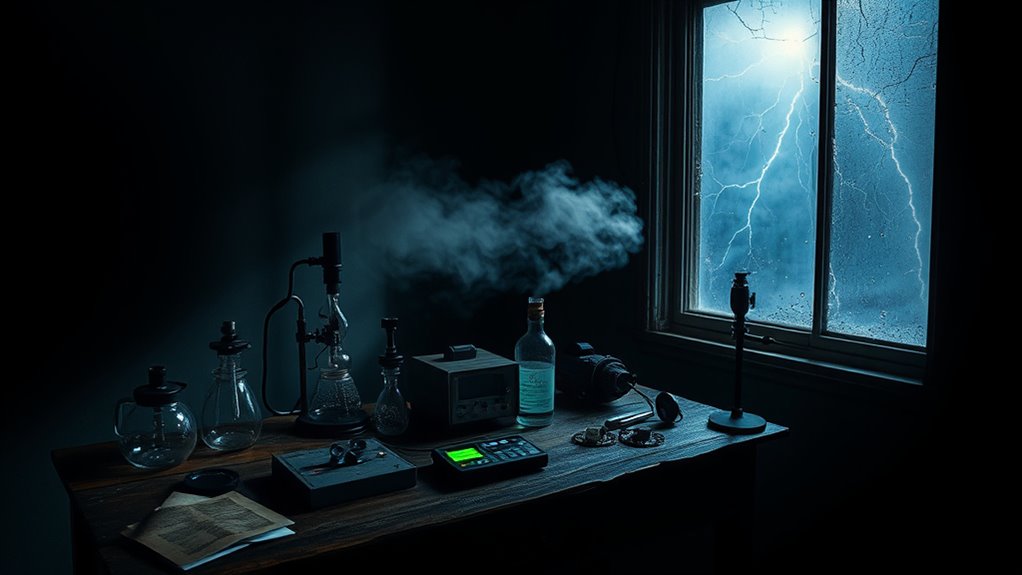
Environmental factors play a significant role in shaping ghost experiences, often creating conditions that lead you to interpret ordinary occurrences as supernatural.
Environmental factors significantly influence ghost experiences, often leading us to misinterpret everyday occurrences as supernatural phenomena.
Here are some key influences to reflect upon:
- Localized drops in temperature can create cold spots, often linked to ghost sightings.
- Rapid changes in temperature may also cause misinterpretations of environmental phenomena, like vibrations or noises.
- Airborne particulates can scatter light, leading to visual anomalies that resemble ghostly apparitions.
- Echoes in large spaces can distort sounds, creating the illusion of disembodied voices.
These factors can shape your perception, making you more susceptible to believing in paranormal activity.
Understanding these environmental influences helps demystify ghost experiences and encourages a more scientific approach to exploring the unknown.
Historical Perspectives on Ghost Investigations
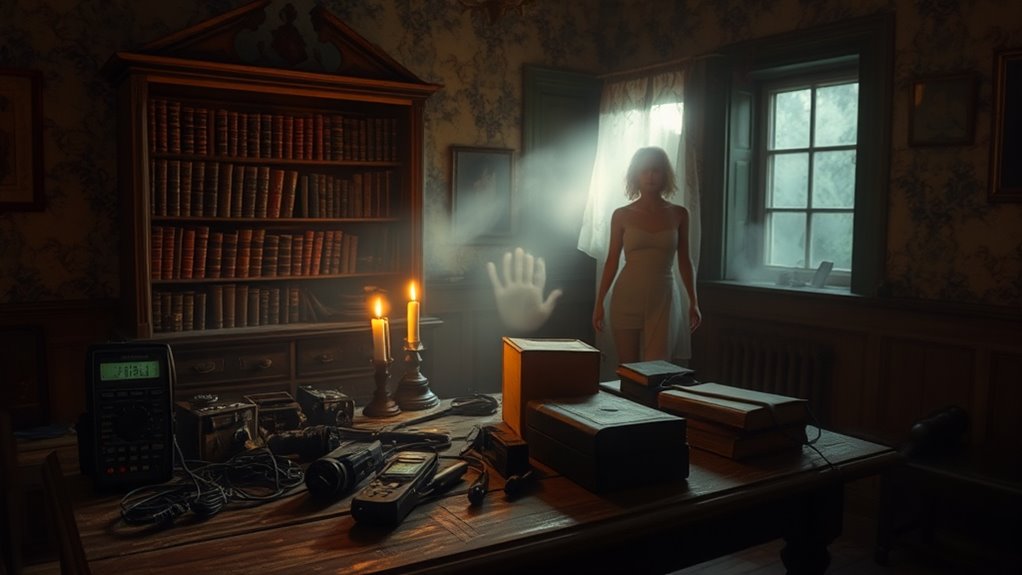
When you look back at the history of ghost investigations, you’ll find a mix of early methods and intriguing cases.
From Harry Price‘s controlled studies at the NLPR to the sensational claims of the Cottingley Fairies, these efforts highlight the evolving approach to understanding the supernatural.
Each investigation reveals not just the beliefs of the time, but also the methods used to challenge or confirm those beliefs.
Early Investigative Methods
Although skepticism surrounding paranormal phenomena has existed for centuries, early investigative methods laid the groundwork for modern ghost research.
Pioneers in ghost hunting sought scientific explanations for spiritual claims, utilizing various investigative techniques under controlled conditions. Here are some key methods they employed:
- National Laboratory of Psychical Research (1926): Founded by Harry Price, focusing on séances and spiritualist claims.
- Mina “Margery” Crandon’s scrutiny: Investigators analyzed her ectoplasmic performances using scientific instruments.
- Cottingley Fairies case (1917): Showcased the lack of rigorous testing, with two cousins photographing alleged fairies.
- Use of cameras and flash photography: Early researchers aimed to capture paranormal phenomena effectively.
These methods marked a significant shift towards a more systematic approach in paranormal investigations.
Notable Cases Reviewed
Early investigative methods set the stage for examining specific notable cases in ghost research, where skepticism and curiosity often collided.
The Cottingley Fairies case, for instance, showed how easily people believe in the supernatural. Frances Griffiths and Elsie Wright’s fairy photographs, later revealed as fakes, highlighted gullibility.
Meanwhile, Boston medium Mina ‘Margery’ Crandon faced scrutiny as ghost hunters used scientific instruments to analyze her ectoplasm during séances, revealing potential fraud.
Harry Price’s National Laboratory of Psychical Research, established in 1926, aimed to understand séance phenomena through controlled conditions.
At Goldsmiths University, researchers continue to explore electromagnetic fields, bridging scientific inquiry and belief.
These historical cases illustrate the ongoing struggle to discern authenticity in paranormal claims.
Case Study: The National Laboratory of Psychical Research

The National Laboratory of Psychical Research (NLPR) represents a pivotal moment in the intersection of science and the supernatural, as it was founded in 1926 by Harry Price to rigorously investigate séance phenomena.
The NLPR aimed to explore psychical phenomena through scientific methods, focusing on the claims of mediums. Here are key aspects of their investigations:
The NLPR rigorously examined psychical phenomena, emphasizing scientific methods to scrutinize the claims of mediums.
- Utilization of 14 cameras, Dictaphones, and barographs.
- Rigorous control measures to validate medium performances.
- Notable study of Mina ‘Margery’ Crandon, known for ectoplasm.
- Emphasis on documenting atmospheric conditions during séances.
This approach marked a significant effort to apply scientific rigor to the paranormal, revealing the tension between belief and empirical investigation in psychical research.
Analyzing the Cottingley Fairies Phenomenon
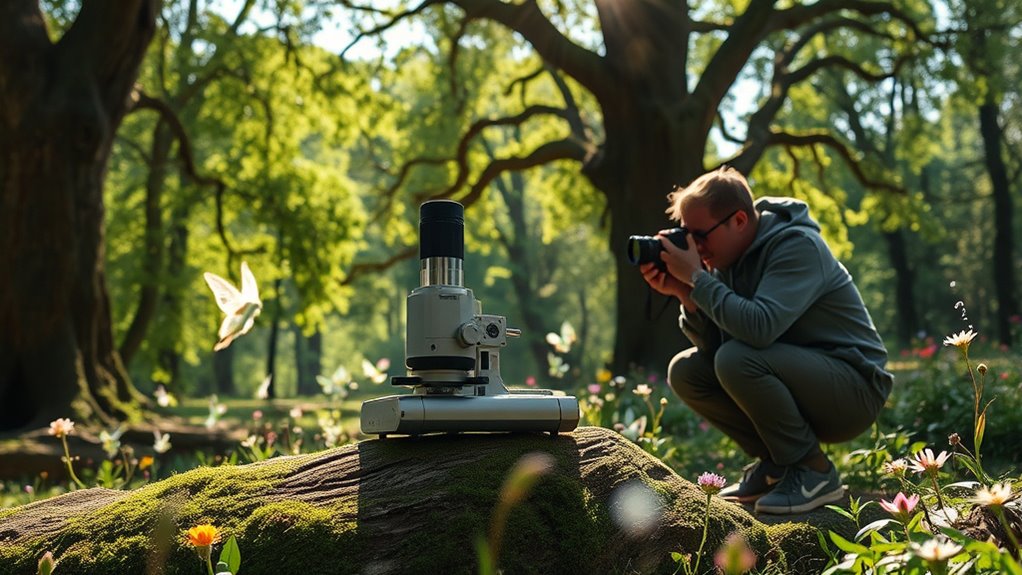
When you look at the Cottingley Fairies case, the scrutiny of photographic evidence becomes essential.
You’ll see how cultural beliefs shaped the public’s perception of these images and fueled their fascination.
Ultimately, this phenomenon highlights the ease with which hoaxes can mislead and the challenges in interpreting such claims.
Photographic Evidence Scrutiny
How can a single photograph spark widespread belief in the supernatural? The Cottingley Fairies phenomenon showcases this phenomenon, where two cousins claimed to have captured images of fairies.
Here’s what you should know about the scrutiny of their photographic evidence:
- The girls used a borrowed family camera in 1917, raising questions about authenticity.
- Arthur Conan Doyle endorsed the photos, despite no scientific verification.
- The Cameo camera allowed for double exposures, complicating the evidence.
- In 1983, Elsie admitted the fairies were faked, calling it a “practical joke.”
These elements highlight the challenges of validating supernatural claims.
They remind us how easily cultural beliefs can lead us to believe in the extraordinary, often without the science behind it.
Cultural Context and Influence
While many people today might dismiss the Cottingley Fairies as a mere hoax, the cultural context of the early 20th century reveals a different story. During this time, interest in the supernatural and belief in ghosts existed prominently in society. The excitement around the fairies captured people’s imaginations, further fueled by figures like Arthur Conan Doyle, who reinforced these cultural narratives.
Such beliefs allowed the girls’ claims to be taken seriously, despite the lack of scientific evidence. When they later admitted to the deception, it highlighted how deeply these narratives affected individuals’ lives, leading to bullying and job loss.
The Cottingley Fairies phenomenon serves as a reminder of the powerful influence cultural beliefs can have on perceptions of reality.
Hoaxes and Misinterpretations
The Cottingley Fairies phenomenon illustrates not just the allure of the supernatural, but also the ease with which hoaxes can take root in a gullible society. Here are four key points to reflect on:
- Cousins’ Confession: Frances Griffiths and Elsie Wright later admitted the photographs were faked as a prank.
- Doyle’s Belief: Arthur Conan Doyle published a book promoting the photographs’ authenticity without thorough investigation.
- Camera Limitations: The Cameo camera allowed for double exposures, complicating authenticity.
- Cultural Gullibility: The widespread belief in these fairy photographs highlights society’s fascination with the supernatural.
Ultimately, the Cottingley Fairies case reminds us how easily hoaxes can deceive when gullibility reigns over skepticism.
Contemporary Methods for Investigating Paranormal Activity
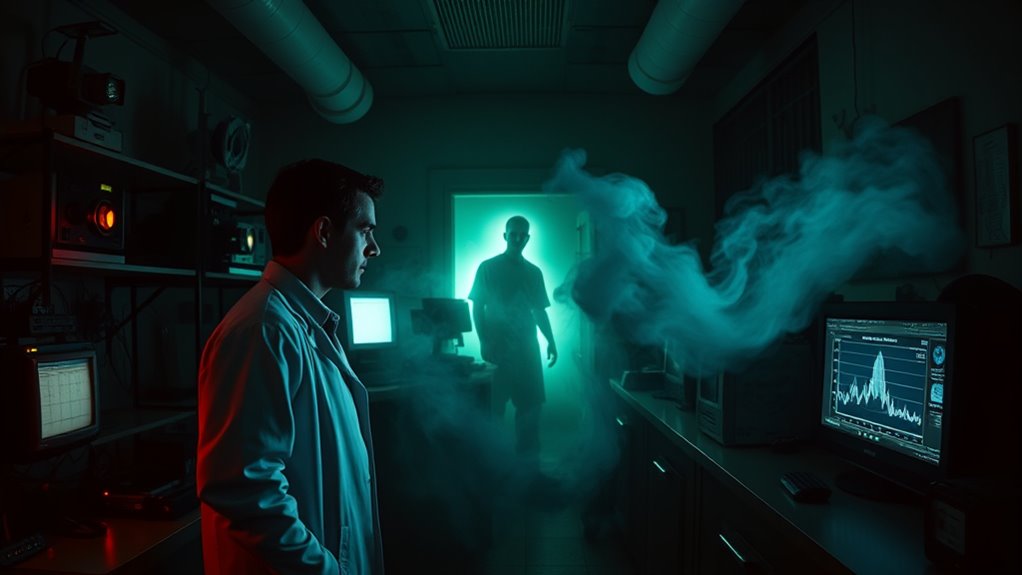
As you explore the world of contemporary methods for investigating paranormal activity, you’ll find that researchers combine psychological assessments with environmental measurements to uncover potential anomalies in reportedly haunted sites.
They use infrared thermometers to detect temperature fluctuations, capturing evidence of unexplained phenomena. Digital voice recorders are essential for identifying Electronic Voice Phenomena (EVPs), mysterious sounds that some attribute to ghostly presences.
Investigators often create controlled environments, like an “artificial haunted room,” to study how infrasound and electromagnetic fields influence participants’ perceptions. This highlights the power of suggestion in recognizing paranormal experiences.
Seeking Evidence: The Future of Ghost Research
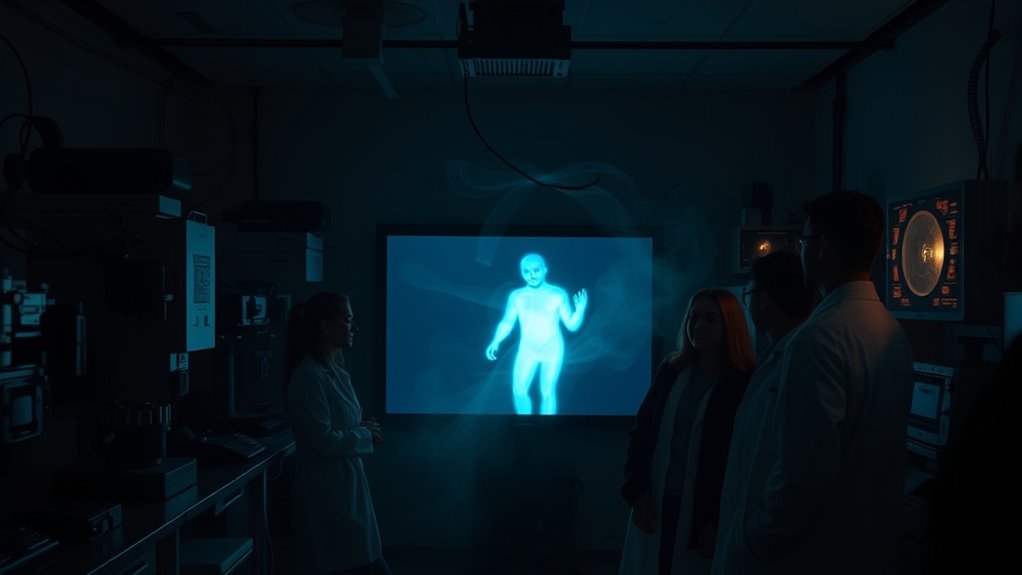
With advancements in technology and methodology, the future of ghost research is poised to become more scientifically rigorous than ever.
This evolution aims to enhance our understanding of paranormal activity through:
- Improved thermal imaging to detect heat signatures linked to ghostly encounters.
- Controlled environments for standardized measures that boost evidence credibility.
- Exploration of psychological factors affecting individuals’ interpretations of ambiguous stimuli.
- Collaborations with experts in neuroscience and environmental science to uncover physiological explanations.
Frequently Asked Questions
Is There Any Scientific Evidence for Ghosts?
There isn’t any scientific evidence for ghosts.
While many people believe in the supernatural, studies show that experiences often attributed to ghosts can usually be explained by psychological or neurological factors.
For instance, environmental influences like infrasound can create sensations that feel ghostly.
Personal beliefs and anecdotal claims are common, but they lack the empirical support needed to confirm the existence of ghosts.
Can Science Explain the Paranormal?
Sure, science can explain many paranormal experiences by examining psychological and environmental factors.
You might find that phenomena like hallucinations or sleep paralysis often lead to ghostly perceptions. Additionally, low-frequency sounds and electromagnetic fields can create feelings of unease, making you interpret normal sensations as supernatural.
What Do You Call Someone Who Investigates the Paranormal?
You’d call someone who investigates the paranormal a “paranormal investigator” or a “ghost hunter.”
These individuals explore alleged supernatural phenomena, often using scientific methods and tools. They might work solo or as part of a team, collaborating with others who share their interest.
Equipped with gadgets like EMF meters and night vision cameras, they aim to document their findings and analyze claims of ghost sightings, contributing to the growing fascination with the unexplained.
What Are Some Theories About Ghosts?
When you explore theories about ghosts, you’ll encounter a mix of psychological and supernatural ideas.
Some suggest that your experiences might stem from hallucinations or sleep paralysis. Others believe ghosts are spirits of the deceased or residual energy from past events.
Speculative theories even connect them to concepts like quantum entanglement.
Environmental factors, like temperature drops or strange sounds, can also create conditions that lead you to misinterpret everyday phenomena as ghostly encounters.
Conclusion
In your quest to understand ghost theories, remember that skepticism and curiosity can coexist. By examining cases like the Cottingley Fairies, where belief and deception intertwined, you can appreciate the complexities of paranormal claims. Whether you’re exploring haunted locations or simply pondering your own experiences, staying open-minded yet critical will enrich your journey. As you seek evidence, consider how both the mind and environment shape your perceptions—after all, the truth behind the supernatural may be more fascinating than the ghosts themselves.

